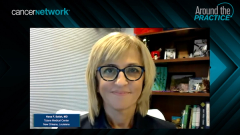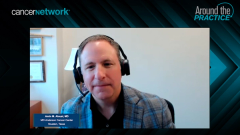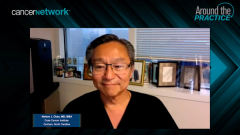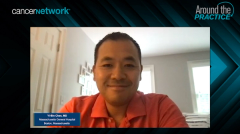
GVHD in the Context of Stem Cell or Allogeneic Transplant
Expert panelists elucidate the occurrence of graft vs host disease in patients receiving either stem cell or allogeneic transplantation.
Episodes in this series

Transcript:
Yi-Bin Chen, MD: Welcome to this Cancer Network presentation, Developments in Graft versus Host Disease Prevention and Treatment. I am your host, Dr Yi-Bin Chen. I am the director of the hematopoietic cell transplant and cell therapy program and the Rogers Endowed Chair at Massachusetts General Hospital and associate professor of medicine at Harvard Medical School in Boston. Joining me today are my friends and colleagues, Drs Amin Alousi, Nelson Chao, and Hana Safah. Would you introduce yourselves? Nelson, go ahead.
Nelson J. Chao, MD, MBA: I am Nelson Chao. I run the hematology malignancy and cell therapy program at Duke University in Durham, North Carolina.
Yi-Bin Chen, MD: Amin?
Amin M. Alousi, MD: Thank you, Yi-Bin. I am Amin Alousi, professor of medicine at The University of Texas MD Anderson Cancer Center in Houston, and I lead our GVHD [graft versus host disease] program multidiscipline clinic and long-term follow-up. I am the medical director.
Yi-Bin Chen, MD: Hana?
Hana F. Safah, MD: Thank you. I am Dr Safah. I am a professor of medicine at Tulane School of Medicine in New Orleans, Louisiana, and I am the director of the stem cell transplant program, as well as the hematology malignancy program at Tulane.
Yi-Bin Chen, MD: Today we are going to review background information on hematopoietic cell transplants, specifically focusing on graft vs host disease. We will review treatment options, recent development, and future direction. We’ll review a couple of clinical scenarios and discuss the information that we are all using in the clinic to make treatment decisions….Hematopoietic cell transplantation is something that none of us take likely. I think all of our centers perform a good number of these transplants every year, and the numbers are increasing. It’s interesting to think about because not everyone understands why we do transplants and how that is interlaced with this complication of graft versus host disease. Nelson, do you want to talk a little bit about the underlying mechanism of how transplant helps patients, and how that relates to GVHD?
Nelson J. Chao, MD, MBA: Sure. Transplant is the first immunotherapy that we have. It was probably 45 plus years ago when it became pretty clear that you could alter somebody’s immune system with new bone marrow cells. When we do a bone marrow transplant, there tends to be 3 components: you have to ablate the recipient so there is no rejection, give the stem cells with hematopoiesis, and then because of hematopoiesis, you actually replace the immune system. The immune system is a big component of the transplant. You give the preparatory regimen to treat the underlying disease, but the immune system¾ that’s new also¾ can cause what we call graft versus leukemia [GVL] or graft versus tumor effect [GVTE], which is recognizing the host tumor as foreign and getting rid of it. That piece, graft versus leukemia, has a counterpart that is graft versus host [GVH]. Just as leukemia can be formed to the donor cells, host tissue can be formed to the donor cells as well and cause disease we call graft versus host.
Yi-Bin Chen, MD: When I was first training, I was always told that the holy grail in what we do in transplant is finding a way to separate this graft versus leukemia from graft versus host disease. I think we’ve made a lot of efforts , trying to do that over the past few decades, but I’m not sure if they have been super successful. I think that recent work may be starting to do that. I think if you look at where we used to be with transplant back in the 1970s, when this all started or actually gained more popularity, you’ll see there is so much more heterogeneity these days. All of us use a lot of different graft sources. Hana, do you want to talk about the different sources of hematopoietic stem cells that we use these days? And maybe how that has changed over the past few years in terms of popularity?
Hana F. Safah, MD: Of course. The easiest one to speak of is where the stem cell is coming from¾ the peripheral blood versus the bone marrow¾but there is also the umbilical cord. As a transplanter of adult stem cells, I use the cord in a very few instances; it is more common when it comes to using stem cell transplant in the pediatric state. But mostly, it is the peripheral blood versus the bone marrow. With each 1 of those stem cell source and grafts, there are complications that we expect, especially when we are talking about GVHD and mainly chronic GVHD. That has been shown in studies. Data are available that support that with bone marrow stem cells, there is less chronic GVHD and a smaller burden of chronic GVHD on the patients after stem cell transplantation, as well as better recovery and quality of life. However, having said that, between them there isn’t a difference in relapse and overall survival [OS]. Keep that in mind.
Now, first we go through the match-related then we go to the donor themselves. When you look at the donors, you have the match related or the match unrelated. There is mismatch related and there is mismatch unrelated. When we talk about the mismatch related, we are talking mostly about the haploidentical, which is becoming the newest fashion in stem cell transplant. We have learned so much from doing haploidentical stem cell transplants¾ especially when it comes to learning how to take care of GVHD and the effect of treatment that is being applied for haploidentical¾and now it is being used in trials, as well as being used by us in practice to take care of GVHD when we deal with match unrelated or mismatch unrelated.
Yi-Bin Chen, MD: Again, when I first trained¾ and I think that’s true for all of us¾I used to take into account the patient’s donor options to think about a transplant. These days, we accept the transplant if you’re a match sibling, match unrelated donor, mismatch unrelated donor, haploidentical donor, or if you’re using umbilical cord blood. Amin, do we have any data that say that a certain type of donor works best, or whatever that means in terms of overall outcomes? Or is there an algorithm you use at MD Anderson when you’re trying to figure this out?
Amin M. Alousi, MD: Yes, data are still coming in and evolving, but in terms of algorithms at MD Anderson and elsewhere, we still say match-related donors are the top of that algorithm and would be the first donor of choice. The reason for that is because numerous studies have shown lower rates of graft versus host disease and treatment related mortality. In some settings, that may not always be the case. There are data to suggest that if a patient has advanced disease or high-risk disease, that may not apply. There are some conflictingdata to suggest benefits, or lack thereof, if donors are ofolder age, match sibling versus younger age match. There is analysis that we did anumber of years ago within the CIBMTR[Center for International Blood and Marrow Transplant Research] that showed that an older match sibling still has a better algorithm versus an unrelated transplant with regard to complications in GVHD, treatment-related mortality, and overall mortality. Some recent data suggest that in MDS [myelodysplastic syndromes]. That’s no longer the case, but generally speaking, a match related donor is still the preferred donor of the choice. Once you get away from that, there are a number of analyses that suggest comparable outcomes for half-match or haploidentical family member donors as match-term related donors.Data increasingly suggest that outcomes of even mismatch-related donors can be comparable, provided the right type of graft versus host disease prophylaxis is employed in those strategies.
Transcript edited for clarity.
Newsletter
Stay up to date on recent advances in the multidisciplinary approach to cancer.



























































































